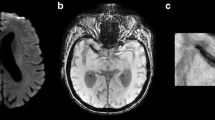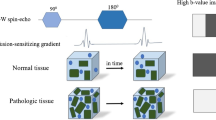Abstract
Susceptibility-weighted imaging (SWI) plays a key role in an emergency setting. SWI takes the intrinsic properties of materials being scanned and creates a visual representation of their effects on the magnetic field, thereby differentiating a number of pathologies. Magnetic resonance imaging (MRI) is now more often used, especially when computed tomography (CT) is inconclusive or even negative. Often, clinicians prefer to obtain an MRI first. This article will review the various hemorrhagic and non-hemorrhagic causes of low signal on SWI. There will be a focus on the distribution patterns of low signal on SWI in pathologies such as diffuse axonal injury, cerebral amyloid angiopathy, and cerebral fat embolism. It is important to recognize these patterns of susceptibility, as the radiologist may be the first to give an accurate diagnosis and therefore, directly impact clinical management.
















Similar content being viewed by others
References
Haacke EM, Mittal S, Wu Z, Neelavalli J, Cheng YCN (2009) Susceptibility-weighted imaging: technical aspects and clinical applications. AJNR Am J Neuroradiol 30(1):19–30
Tong KA, Ashwal S, Obenaus A, Nickerson JP, Kido D, Haacke EM (2008) Susceptibility-weighted MR imaging: a review of clinical applications in children. AJNR Am J Neuroradiol 29:9–17
Mittal S, Wu Z, Neelavalli J, Haacke EM (2009) Susceptibility-weighted imaging: technical aspects and clinical applications, Part 2. AJNR Am J Neuroradiol 30(2):232–252
Kim JJ, Gean AD (2011) Imaging for the diagnosis and management of traumatic brain injury. Neurotherapeutics 8:39–53
Wu Z, Li S, Lei J, An D, Haacke EM (2010) Evaluation of traumatic subarachnoid hemorrhage using susceptibility-weighted imaging. AJNR Am J Neuroradiol 31(7):1302–1310
Van Gijn J, Rinkel GJE (2001) Subarachnoid haemorrhage: diagnosis, causes and management. Brain 124(2):249–278
Caceres JA, Goldstein JN (2012) Intracranial hemorrhage. Emerg Med Clin North Am 30(3):771–794
De Oliveira Manoel AL et al (2016) The critical care management of spontaneous intracranial hemorrhage: a contemporary review. Crit Care 20:272
Aguilar MI, Brott TG (2011) Update in intracerebral hemorrhage. Neurohospitalist 1(3):148–159
Smith DH, Hicks R, Povlishock JT (2013) Therapy development for diffuse axonal injury. J Neurotrauma 30(5):307–323
Greenberg SM, Charidimou (2018) Diagnosis of cerebral amyloid angiopathy. Stroke 49:491–497
Chao CP, Kotsenas AL, Broderick DF (2006) Cerebral amyloid angiopathy: CT and MR imaging findings. RadioGraphics 26(5):1517–1531
Suh S et al (2009) Cerebral fat embolism; susceptibility-weighted magnetic resonance imaging. Arch Neurol 66(9):1170
Leach JL, Strub WM, Gaskill-Shipley MF (2007) Cerebral venous thrombus signal intensity and susceptibility effects on gradient recalled-echo MR imaging. AJNR Am J Neuroradiol 28:940–945
Lu A et al (2016) Cerebral venous thrombosis and infarct: review of imaging manifestations. Appl Radiol 45(3):9–17
Kumar N (2010) Neuroimaging in superficial siderosis: an in-depth look. AJNR Am J Neuroradiol 31(1):5–14
Assarzadegan F et al (2013) Superficial siderosis: a rare case of ataxia and otoneurological manifestations. Iran J Neurol 12(2):69–71
Dabdoub CB, Salas G, Silveira EN, Dabdoub CF (2015) Review of the management of pneumocephalus. Surg Neurol Int 6:155
Hargreaves B et al (2011) Metal induced artifacts in MRI. AJR 197(3):547–555
Gregory A, Hayflick S (2005) Neurodegeneration with brain iron accumulation disorders overview. Folia Neuropathol 43(4):286–296
Kruer MC, Boddaert N, Schneider SA, Houlden H, Bhatia KP, Gregory A, Anderson JC, Rooney WD, Hogarth P, Hayflick SJ (2012) Neuroimaging features of neurodegeneration with brain iron accumulation. AJNR Am J Neuroradiol 33(3):407–414
Gulani V, Calamante F, Shellock FG, Kanal E, Reeder SB (2017) Gadolinium deposition in the brain: summary of evidence and recommendations. Lancet Neurol 16:564–570
Thomas-Sohl KA, Vaslow DF, Maria BL (2004) Sturge-Weber syndrome: a review. Pediatr Neurol 30:303–310
Watts J, Box G, Galvin A, Brotchie P, Trost N, Sutherland T (2014) Magnetic resonance imaging of meningiomas: a pictorial review. Insights Imaging 5(1):113–122
Khalid L, Carone M, Dumrongpisutikul N, Intrapiromkul J, Bonekamp D, Barker PB, Yousem DM (2012) Imaging characteristics of oligodendrogliomas that predict grade. AJNR Am J Neuroradiol 33:852–857
Smits M (2016) Imaging of oligodendroglioma. Br J Radiol 89(1060):20150857
Lee IH, Zan E, Bell WR, Burger PC, Sung H, Yousem DM (2016) Craniopharyngiomas: radiological differentiation of two types. J Korean Neurosurg Soc 59(5):466–470
Author information
Authors and Affiliations
Corresponding author
Ethics declarations
Conflict of interest
The authors declare that they have no conflict of interest.
Rights and permissions
About this article
Cite this article
Skalski, K.A., Kessler, A.T. & Bhatt, A.A. Hemorrhagic and non-hemorrhagic causes of signal loss on susceptibility-weighted imaging. Emerg Radiol 25, 691–701 (2018). https://doi.org/10.1007/s10140-018-1634-7
Received:
Accepted:
Published:
Issue Date:
DOI: https://doi.org/10.1007/s10140-018-1634-7




